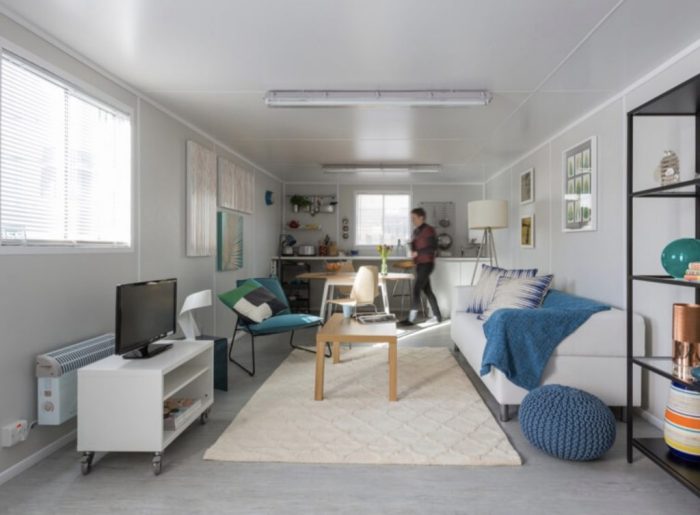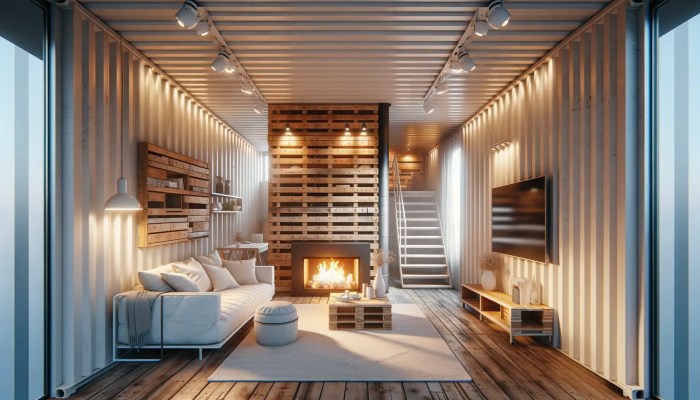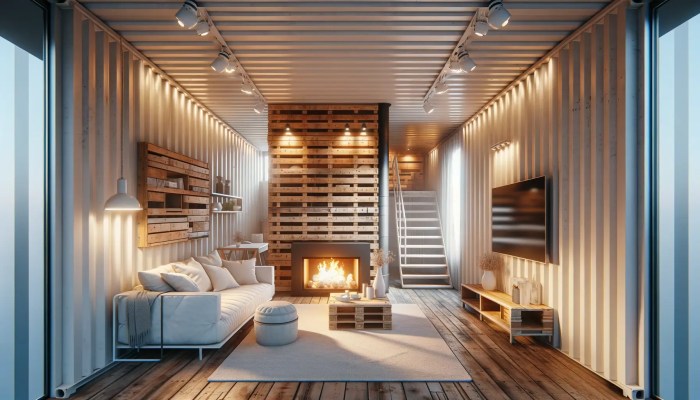Container van house interior design is gaining popularity as a sustainable and affordable housing solution. These unique homes offer a blend of practicality and creativity, allowing individuals to transform shipping containers into comfortable and stylish living spaces.
The challenge lies in maximizing space utilization while incorporating design elements that create a sense of openness and functionality. From clever storage solutions to innovative lighting techniques, container van home interior design demands a resourceful approach to create a welcoming and functional living environment.
The Appeal of Container Van Homes: Container Van House Interior Design

The idea of living in a container van may seem unconventional, but it has become increasingly popular in recent years. This unique approach to housing offers a blend of affordability, portability, and sustainability, attracting a diverse range of individuals seeking alternative living arrangements.
Container van house interior design is all about maximizing space and creating a comfortable living environment within a limited footprint. You can learn a lot from the principles of 500 square feet house interior design , which often involves clever storage solutions and multi-functional furniture.
Just like a small house, a container van home requires careful planning and creative design to make the most of every inch.
Reasons for Growing Popularity
The popularity of container van homes is driven by a confluence of factors, including:
- Affordability:Container van homes can be significantly cheaper to build and maintain than traditional houses. The cost of a used shipping container is relatively low, and the construction process is often simpler and faster.
- Portability:Container vans offer the freedom to move to different locations easily. This is particularly appealing to those who enjoy traveling or seeking a change of scenery.
- Sustainability:Reusing shipping containers reduces waste and promotes sustainability. The use of recycled materials and energy-efficient design features can further minimize environmental impact.
- Minimalism:Container van living encourages a minimalist lifestyle. This can be appealing to those who value simplicity and prioritize experiences over material possessions.
Advantages and Disadvantages
While container van homes offer numerous advantages, it is essential to consider potential drawbacks as well.
Advantages
- Lower Initial Costs:Compared to traditional homes, container van homes require a significantly lower upfront investment, making them an attractive option for budget-conscious individuals.
- Flexibility and Mobility:Container vans can be easily transported, offering the flexibility to move to different locations as needed. This is particularly appealing to individuals seeking a nomadic lifestyle or those who need to relocate frequently for work or personal reasons.
- Sustainability and Environmental Friendliness:The use of recycled shipping containers promotes sustainability by reducing waste and minimizing environmental impact. The compact size of container van homes also reduces energy consumption for heating and cooling.
- Minimalism and Simplicity:Container van living encourages a minimalist lifestyle, fostering a focus on experiences and reducing the burden of material possessions.
Disadvantages
- Limited Space:Container van homes offer limited living space, requiring careful planning and organization to maximize functionality.
- Potential for Heat and Cold:Container vans can be prone to extreme temperatures, especially in hot or cold climates. Proper insulation and ventilation are crucial for maintaining a comfortable living environment.
- Limited Amenities:Container van homes may lack access to certain amenities, such as full-sized bathrooms or large kitchens. Creative solutions and compromises are often required to adapt to these limitations.
- Regulations and Restrictions:Regulations and restrictions on parking and living in container vans can vary depending on location. It is essential to research and comply with local ordinances before converting a container into a home.
Examples of Successful Container Van Home Projects
Many individuals have successfully transformed shipping containers into functional and stylish homes. Here are some notable examples:
- The Tiny House on Wheels:A couple in the United States built a cozy and efficient container van home on wheels, allowing them to travel and explore different parts of the country.
- The Off-Grid Container Home:A family in Australia created an off-grid container van home powered by solar energy and rainwater collection, showcasing the potential for sustainable living.
- The Modern Container Home:A designer in Europe converted a shipping container into a minimalist and modern home, demonstrating the adaptability of container van living to different design aesthetics.
Space Planning and Layout

Transforming a container van into a home requires meticulous planning and a keen eye for maximizing every inch of space. This involves carefully considering the layout, functionality, and flow of the living area within the confined dimensions of the container.
Floor Plan Design
Designing a floor plan for a container van home necessitates a balance between functionality and aesthetics. The layout should accommodate essential living areas, such as sleeping, cooking, dining, and storage, while maintaining a sense of spaciousness. Here are some common layouts:
- Linear Layout:This layout positions the living areas in a straight line along the length of the container. This is a simple and efficient design, suitable for smaller vans. For example, the front section could be designated for sleeping, followed by a kitchen area, and finally, a bathroom at the rear.
Container van house interior design offers a unique challenge, requiring creative solutions to maximize space within a limited footprint. While the principles of a house interior design apply, the container’s shape and size necessitate a different approach. This often involves incorporating clever storage solutions, multi-functional furniture, and strategic use of color and light to create a sense of spaciousness and comfort within the confined space.
- L-Shaped Layout:This layout utilizes the corner of the container to create an L-shaped living area. This maximizes space by creating distinct zones for different functions. For instance, the kitchen could be placed along one side, while the sleeping area occupies the other side, forming an L-shape.
- Open-Plan Layout:This layout combines all living areas into one open space, creating a sense of openness and spaciousness. This is ideal for smaller vans where maximizing visual space is essential. However, it requires careful planning to ensure the areas are well-defined and functional.
Container van house interior design is all about maximizing space and creating a cozy atmosphere within a limited footprint. You can draw inspiration from various design eras, such as the 1920s house interior design , which featured Art Deco elements like geometric patterns and luxurious materials.
Incorporating these elements into your container van home can add a touch of vintage charm and sophistication, creating a unique and inviting space.
Maximizing Space Utilization, Container van house interior design
Space is a premium in a container van home. To maximize its use, consider these suggestions:
- Multifunctional Furniture:Utilize furniture that serves multiple purposes. For instance, a sofa bed can double as a sleeping area, a dining table can be converted into a work desk, and storage can be integrated into furniture designs.
- Vertical Storage:Take advantage of vertical space by incorporating shelves, cabinets, and drawers on the walls. This maximizes floor space and creates a clutter-free environment.
- Compact Appliances:Opt for compact appliances, such as a mini-fridge, a portable oven, and a small sink, to save space and minimize energy consumption.
Natural Light and Ventilation
Natural light and ventilation are crucial for creating a comfortable and healthy living environment in a container van home. Consider these factors:
- Skylights:Incorporate skylights to allow natural light to penetrate the interior. This can significantly brighten the space and reduce the need for artificial lighting during the day.
- Windows:Strategically placed windows provide natural light and ventilation. Consider using large windows to maximize light entry and create a sense of openness.
- Ventilation System:Install a ventilation system to ensure proper air circulation. This can include fans, vents, or a combination of both. This is especially important for areas with high humidity or where cooking takes place.
Ending Remarks

Designing a container van home interior is a rewarding journey that combines creativity, practicality, and a commitment to sustainable living. By embracing innovative solutions and incorporating thoughtful design elements, you can transform a seemingly limited space into a beautiful and functional home that reflects your personal style and needs.
Answers to Common Questions
How much does it cost to build a container van house?
The cost of building a container van house varies depending on factors like the size of the container, the materials used, and the level of customization. However, container van homes are generally considered more affordable than traditional houses.
What are the challenges of living in a container van house?
Living in a container van house can present challenges such as limited space, potential for heat gain and loss, and the need for creative storage solutions. However, with careful planning and design, these challenges can be overcome.
Are container van houses legal?
Building regulations for container van houses vary by location. It’s essential to research local building codes and obtain necessary permits before starting construction.
